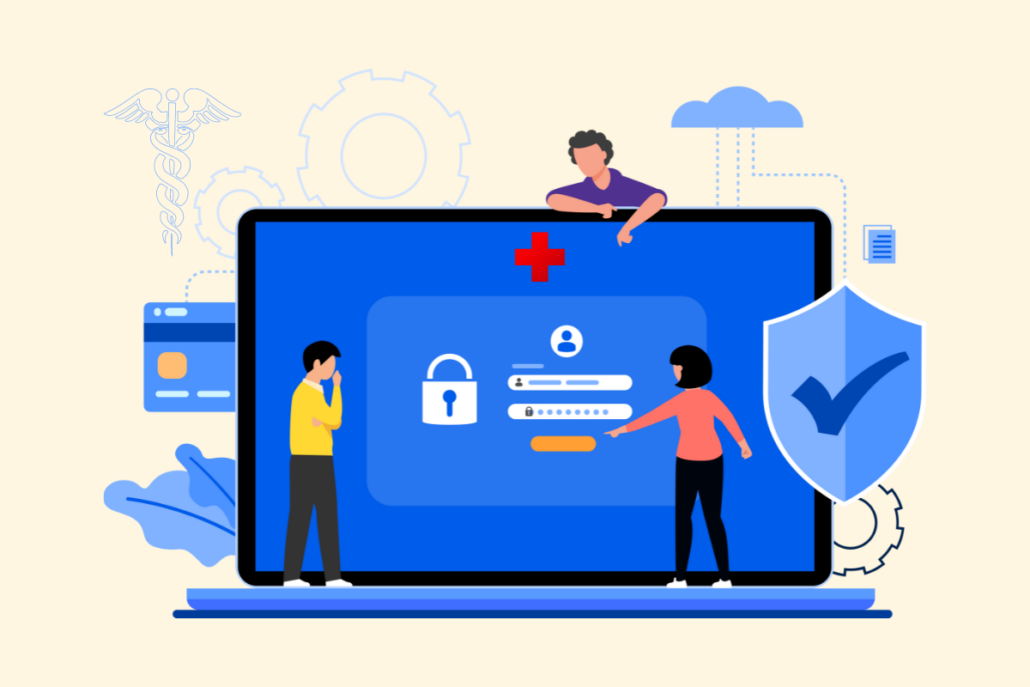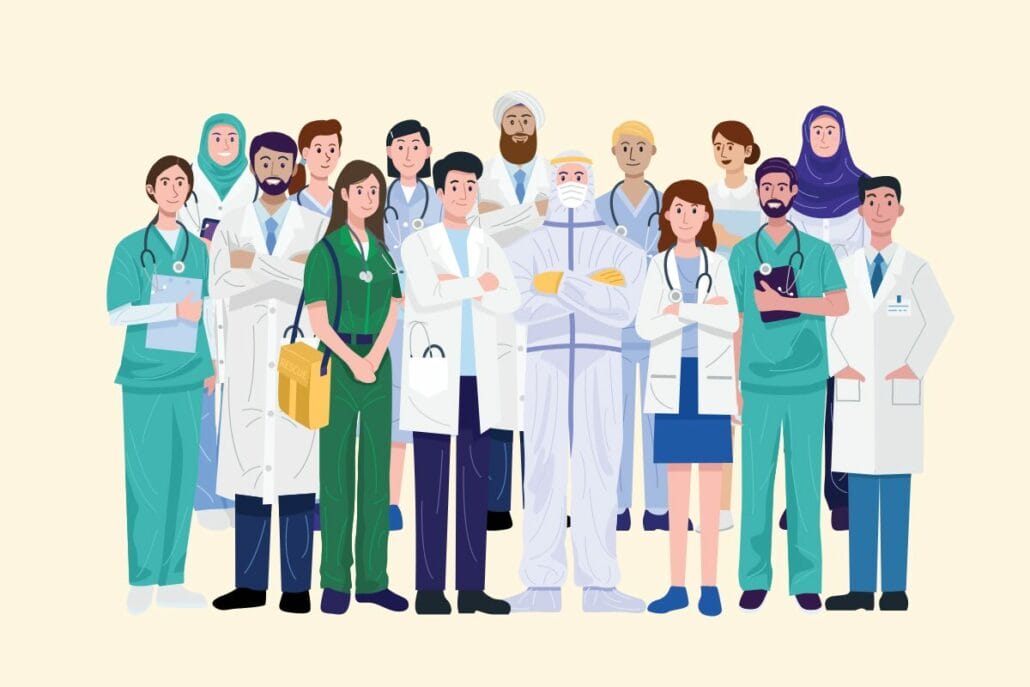Human resource professionals typically handle recruiting, hiring, training, and maintaining a positive work environment. In the healthcare field, however, the HR function becomes even more demanding. Healthcare human resource professionals have an added responsibility to handle regulatory compliance, high turnover, and more. This article breaks down the roles of HR in healthcare, the its challenges, and the strategies used to support healthcare workers and improve patient care.
Key Takeaways
- Human resources in healthcare organizations handle staffing, training, workplace culture, and compliance, directly impacting the quality of patient care and employee well-being.
- Key challenges in healthcare HR include workforce shortages, regulatory compliance, and employee burnout, all of which require innovative strategies and robust management.
- Effective HR management strategies, such as advanced talent acquisition, continuous professional development, and technology integration, are essential for maintaining an efficient, satisfied workforce and improving patient care.
The Role of Human Resources in Healthcare

Human resources teams in healthcare organizations are responsible for:
- Hiring and onboarding new employees
- Fostering a positive workplace culture
- Advancing employees’ careers
- Ensuring compliance with policies and regulations
- Managing employee benefits and compensation
HR’s job is not just about filling positions but about ensuring that healthcare workers are well-prepared and motivated to provide the best possible care.
Human resource management in healthcare critically involves:
- Maintaining adequate staff levels for optimal patient care delivery
- Rigorous workforce planning
- Development of hiring practices that attract the most qualified candidates
- Creating and enforcing training programs as part of both onboarding and employee development
Effective hiring practices are crucial as they directly impact the quality of health care services provided. Moreover, HR professionals recognize that the difference between a poorly trained and a well-trained employee affect patient quality of life, and can sometimes be a matter of life or death.
HR teams in healthcare play a pivotal role in fostering a positive work environment. This includes:
- Addressing high rates of employee turnover
- Providing support for employees’ mental and physical health
- Promoting a culture of compliance and continuous improvement
- Handling employee relations and conflict resolution
Nurse leaders who transition into HR roles bring a unique advantage—they possess empathy for their colleagues’ issues, can provide valuable advice and resources, and are adept at fostering nurturing work environments.
Furthermore, the success of healthcare HR management is often measured based on patient outcomes and satisfaction levels. This underscores the direct link between effective human resources management and improved care for patients. By ensuring that healthcare staff are adequately supported and developed, HR departments contribute significantly to the overall quality of health care facilities and services.
Human resources are essential in maintaining a robust and effective health care system, working closely with health care providers, health care workers, and medical professionals to ensure the delivery of quality health services.
Key Challenges in Healthcare Human Resource Management

Navigating the complex landscape of healthcare human resource management is no small feat. HR teams face a plethora of challenges that can impede their ability to maintain an efficient and satisfied workforce. Among the most pressing issues are workforce shortages, regulatory compliance, and employee burnout. These challenges require human resource management to balance the needs of employees with the goals of the organization to ensure high-quality patient health care delivery.
Some of the challenges facing the healthcare industry include:
- Staffing shortages, which have significant implications for health care services and patient outcomes.
- Compliance with stringent regulations, where failure can result in severe penalties and compromised patient care.
- Employee burnout, which remains a pervasive issue and threatens to undermine the stability and effectiveness of healthcare institutions.
Workforce Shortages
The United States is staring down the barrel of a significant shortage of medical professionals. While healthcare worker demand is anticipated to climb by 11% through 2036, the supply of medical workers is expected to drop. According to the American Hospital Assocation, there will be a critical shortage of 3.2 million health care workers by 2026. This shortage strains resources and leads to increased nurse burnout, which in turn affects the quality of patient care.
Maintaining appropriate staffing levels is not only vital for reducing stress among healthcare workers but also for minimizing the risk of errors in care. HR managers in healthcare must develop innovative strategies to attract and retain staff amid this significant talent shortage. The hiring process must be streamlined and efficient, focusing on bringing in the most qualified candidates to bolster the health care industry’s workforce.
In this environment, human resources professionals must be adept at workforce planning and talent acquisition. By fostering a supportive work culture and offering competitive benefits, HR can help ensure that employees stay, thus mitigating the effects of workforce shortages on healthcare facilities.
Regulatory Compliance

Regulatory compliance is a cornerstone of effective healthcare human resource management. Health care HR teams are responsible for ensuring that all employees comply with various safety, privacy, and training regulations. Key among these are the Health Insurance Portability and Accountability Act (HIPAA) and the Emergency Medical Treatment and Labor Act (EMTALA), which set stringent standards for patient data privacy and emergency care.
Collaboration between human resource management and IT departments is necessary for implementing robust data security measures to protect sensitive patient and employee information from breaches. Creating a culture of compliance is essential to safeguarding a healthcare organization against financial penalties and lawsuits, emphasizing the need for continuous monitoring and updating of policies to stay aligned with federal laws and licensing requirements.
Employee Burnout in Medical Professionals
Employee burnout is a pervasive issue in the healthcare industry, with 55% of healthcare workers reporting symptoms of burnout. This high level of emotional distress not only affects individual well-being but also leads to increased turnover rates and decreased patient satisfaction.
Another result of burnout can result in nurses finding side jobs that are not as demanding or that better meet their personal schedule. Some of the alternative jobs available to nurses, such as mentoring, can increase the number of medical professionals in the field. Other jobs take them off the market, such as transitioning to writers or finding work in a medical-related field.
Healthcare HR teams can play a crucial role in mitigating burnout by providing resources such as mental health care, support groups, and flexible work arrangements. Adjusting staff schedules, offering stress management workshops, and promoting a healthy working environment are essential strategies to help employees stay motivated and engaged.
Some companies have added above and beyond benefits to help prevent burnout. Recent job ads offered an annual, all-inclusive, company-paid vacation package. This incentive not only attracts more prospects, but also help prevent burnout for workers in the most at-risk roles.
Proactively addressing burnout allows HR professionals to enhance organizational effectiveness and improve patient health care delivery overall.
Effective Human Resources Management Practices in Healthcare
Developing robust strategies that enhance efficiency and employee satisfaction is vital for tackling the myriad challenges faced by healthcare human resource management. These strategies encompass talent acquisition and retention, professional development and training, and technology integration. By focusing on these areas, HR managers can ensure that healthcare organizations remain competitive and provide high-quality patient health care.
Human resource management practices, when effectively implemented, can improve employee retention, contribute to better patient outcomes, and enhance organizational effectiveness. The following subsections will delve into specific strategies for talent acquisition and retention, professional development and training, and technology integration.
Talent Acquisition and Retention

Innovative recruitment strategies are essential for attracting and retaining top healthcare talent. Some effective strategies include:
- Leveraging Internet recruitment
- Collaborating with universities
- Creating student recruitment programs
- Using AI technology to screen resumes and schedule interviews
Investing in leadership development and offering career advancement opportunities are also crucial for retaining lower-wage healthcare workers. Implementing career advancement mobility programs can also help reduce turnover and improve retention rates in the healthcare sector. These strategies ensure that healthcare organizations maintain a competitive advantage and continue to provide high-quality patient care.
Competitive compensation packages and benefits, such as childcare services, can further enhance employee retention and satisfaction. By focusing on talent acquisition and retention, human resource departments can build a strong and dedicated healthcare workforce.
Professional Development and Training

Continuous education and professional development investments are key to maintaining a competitive edge in the healthcare labor market. Organizations like Cleveland Clinic emphasize personnel training with over 50 courses annually, attended by more than 7,000 technicians and other medical professionals. Such initiatives ensure that healthcare professionals are properly trained in the latest medical developments and regulatory standards.
Providing comprehensive training tailored to specific job roles is essential for ensuring that hospital staff and medical personnel are adequately prepared. For instance, Massachusetts General Hospital conducts an annual Career Development Conference to align employees’ personal expectations with their growth and departmental goals.
Johns Hopkins Hospital uses an electronic performance appraisal system and provides comprehensive career development counseling through the REACH program.
Leadership development programs, including mentorship and succession planning, are crucial for preparing future healthcare leaders. By promoting these health care program initiatives, human resource management can foster a culture of continuous learning and professional growth, ultimately leading to more positive patient outcomes and improved employee satisfaction.
Technology Integration
Integrating advanced HR software and automation tools can significantly streamline human resources operations and improve efficiency in health care organizations. Scheduling software and automation of administrative tasks, such as onboarding, payroll processing, and benefits administration, can reduce the administrative burden on human resources professionals.
- ADP Workforce Now, for example, is a platform that handles HR and payroll tasks, integrating with various companies and offering different products to automate these processes. Additional modules can be purchased and integrated to meet the unique needs of each organization.
- Kronos Workforce Ready is a full featured platform for healthcare HR and receives high reviews, but is best suited for large organizations due to its cost.
- Oracle Fusion Cloud Human Capital Management can automate and improve hiring processes, simplify staff scheduling, and connect staff and medical personnel with needed training.
- HR for Health is a top HR software choice for healthcare practices because it is specifically designed for the unique needs of healthcare professionals. Unfortunately, it lacks a tool for staffing or for scheduling within a practice.
Despite their pros and cons, these technologies not only enhance flexibility and autonomy for workers but also improve communication and engagement among staff. Moreover, using e-forms and time-off tracking tools can help streamline administrative tasks and boost efficiency. By embracing technology integration, human resource professionals can ensure timely and effective management of the health care workforce, leading to better organizational transformation and performance management.
Building a Positive Work Culture in Healthcare

Fostering a positive work culture is paramount for attracting and retaining employees in health care organizations. A people-first culture that supports employee well-being, including mental and physical health, financial needs, and work-life balance, significantly improves recruitment and retention. Human resource managers are increasingly focusing on creating a supportive and inclusive workplace that promotes diversity, equity, inclusion, and belonging (DEIB) initiatives.
Open communication is a cornerstone of a positive work culture, allowing team members to express ideas and concerns freely, thereby enhancing engagement and collaboration. Promoting teamwork and collaboration can boost motivation and respect among healthcare staff, leading to improved patient health care delivery. Recognizing and valuing employees’ contributions through appreciation programs also fosters job satisfaction and loyalty.
Supporting work-life balance through flexible schedules and self-care promotion helps maintain employees’ mental health and well-being. Implementing DEIB initiatives is crucial for fostering an inclusive workplace, which in turn leads to improved patient care and a more harmonious organizational culture. Training programs on diversity, equity, and inclusion educate employees on unconscious bias and cultural competency, further enhancing the work environment.
Creating comprehensive employee orientation, instituting mentorship programs, recognizing and rewarding employee achievements, and promoting open dialogue with senior level staff are additional strategies that can improve workplace culture. By focusing on these aspects, HR can build a positive and supportive work environment that enhances employee satisfaction and retention.
Case Studies on Successful Healthcare Human Resource Practices
Examining successful human resource practices in healthcare settings provides valuable insights into what works and why.
One example is a healthcare organization that partnered with local universities to create internship programs, leading to an increase in new hires. This innovative talent acquisition strategy not only addressed workforce shortages but also provided students with valuable hands-on experience.
The Children’s Hospital of Philadelphia successfully improved employee retention by offering flexible working hours and professional development opportunities, resulting in a notable reduction in staff turnover. This approach highlights the importance of healthcare organizations addressing employees’ work-life balance and professional development needs to enhance retention.
Finally, integrating advanced scheduling software helped a healthcare provider streamline their HR processes, significantly reducing the administrative workload and improving overall efficiency. These case studies demonstrate that innovative HR practices can significantly enhance employee satisfaction and patient health care delivery.
Future Trends in Healthcare Human Resources
With the continuous evolution of the healthcare industry, HR departments need to adapt to emerging trends in order to stay competitive and enhance productivity. One such trend is the implementation of strategies and tools to effectively manage remote healthcare teams. With the rise of telehealth and remote work options, the HR professional needs to develop policies that support flexible work arrangements while maintaining high standards of patient care.
HR analytics is another crucial trend, enabling data-driven decision-making to improve hiring, retention, and employee satisfaction in the health care industry. Predictive analytics can forecast future workforce needs and challenges, optimizing workforce planning and ensuring that healthcare facilities and organizations are prepared for potential staffing shortages. By using data and algorithms, HR can make informed decisions while promoting diversity, equity, inclusion, and belonging (DEIB) principles.
Real-time performance monitoring tools provide immediate insights into employee productivity and effectiveness. Some benefits of using these tools include:
- Immediate feedback on employee performance
- Objective evaluation of performance using quantitative metrics
- Identification of areas for improvement and development
In addition, staying updated on emerging technologies like artificial intelligence (AI) and the Internet of Things (IoT) is essential for HR managers to enhance productivity and streamline HR processes.
Adopting flexible work policies, including remote and hybrid options, helps attract and retain top healthcare talent. These policies not only improve work-life balance but also increase job satisfaction and reduce turnover rates.
Finally, embracing digital and web-based technologies for record-keeping, information sharing, and hospital asset tracking can further enhance the efficiency of healthcare facilities. Health care inventory managers use digital systems to track the flow of medical products, ensuring that supplies are available when needed and reducing patient risk.
As health information technology continues to advance, HR departments must remain agile and open to incorporating new tools and strategies to improve patient satisfaction and employee satisfaction.
Summary
In summary, enhancing efficiency in healthcare human resources management is crucial for maintaining a high-quality workforce and delivering exceptional health services. By addressing key challenges such as workforce shortages, regulatory compliance, and employee burnout, HR professionals can develop effective strategies for talent acquisition and retention, professional development and training, and technology integration.
Building a positive work culture and staying abreast of future trends are also essential components of a successful healthcare human resource professional. By fostering a supportive and inclusive work environment, healthcare organizations can attract and retain top talent, and ultimately improve patient outcomes and satisfaction. As we move forward, the role of HR in healthcare will continue to evolve, and staying informed and adaptable will be key to overcoming challenges and achieving success.
Frequently Asked Questions
What are the main responsibilities of HR in healthcare?
In healthcare, HR’s main responsibilities include recruiting, hiring, onboarding, fostering a positive workplace culture, supporting career advancement, and ensuring policy and regulation compliance. These tasks are essential for maintaining a healthy and productive work environment.
How do workforce shortages impact health care?
Workforce shortages in health care can strain resources, lead to burnout among healthcare workers and nursing staff, and increase the risk of errors when caring for patients. It is crucial to ensure appropriate staffing levels to reduce stress and improve care quality.
What strategies can HR use to reduce employee burnout?
HR can reduce employee burnout by providing resources such as mental health care, support groups, flexible work arrangements, adjusting staff schedules, and offering stress management workshops. These strategies can help employees feel supported and better able to manage their workload.
How does technology integration benefit healthcare HR?
Technology integration benefits healthcare human resources by streamlining operations, improving efficiency, automating administrative tasks, enhancing communication, and supporting flexible work arrangements, ultimately leading to better workforce management.
What future trends should healthcare HR be aware of?
Healthcare HR should be aware of managing remote health care teams, using HR analytics for data-driven decision-making, adopting flexible work policies, and staying updated on emerging technologies like AI and IoT. Staying informed and adaptable is essential for meeting future challenges in health care HR.


